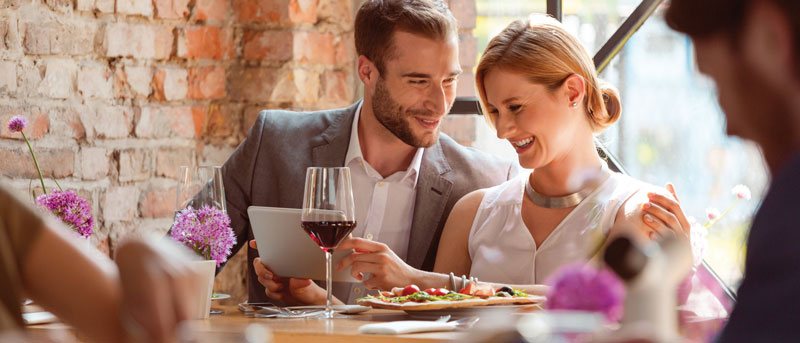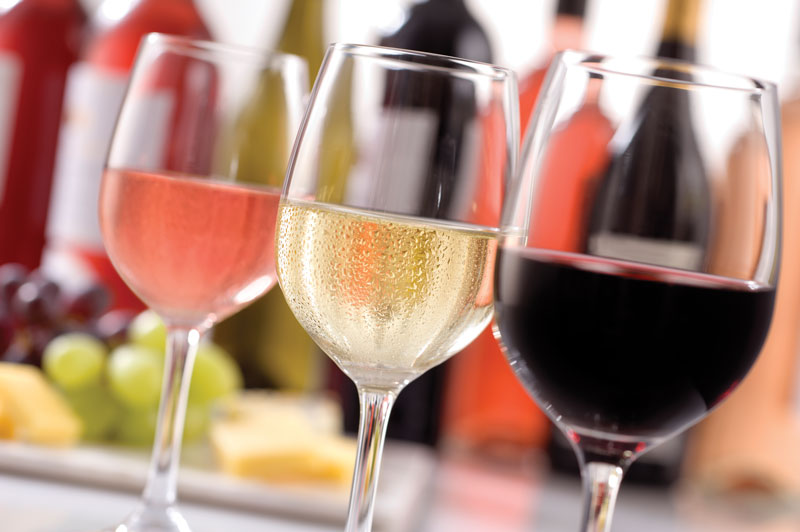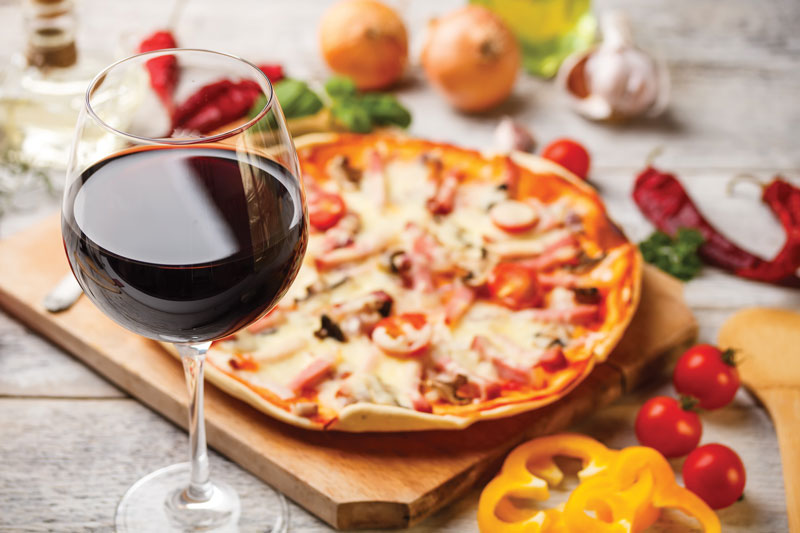Gone are the days when wine was reserved for the snobby upper-class; with a plethora of possibilities at all price ranges, more people are enjoying a glass of vino with their meals at casual and upscale restaurants alike. In fact, says wine consultant John Juergens, owner of Vin-Test in Oxford, Mississippi, per capita wine consumption is rising in the United States. According to the Wine Institute, 2014 marked the 22nd consecutive year of growth for all wine sales in the country, which has been the world’s largest wine market since 2010.
Of course, Italians never miss an opportunity to serve up their own fine dishes, such as pizza and pasta, alongside a hearty glass of the grape. If you’re not already serving wine at your operation, you could be missing out on the many benefits a proper program provides: an improved and more authentically Italian customer experience as well as boosted profits. “There’s always been a natural camaraderie between pizza and wine,” Juergens notes. “They just go together well.”

Menu Management
Smaller operations needn’t dive in headfirst to an extensive wine program; starting small and building your list is a more prudent option. “Independent pizzerias should do some research and start slow; you can even get by with two wines, a house white and house red, such as a Pinot Grigio and Chianti,” Juergens says. “These should be good-quality and moderately priced. Fortunately, there are tons of great, inexpensive wines out there.”
Just don’t let your wine menu go stale—Juergens recommends refreshing the list perhaps monthly, either bringing in a new wine or changing up the house selections, to stave off customer boredom and to determine what sells best. For larger lists, a mix of whites and reds—including a couple of recognizable Italian wines—will satisfy a range of tastes. And when in doubt, think red first, he adds, because red wines pair especially well with tomato sauce.
|
Hitting the Right Price Point |
| Setting a price for your wine can be tricky. According to Rob Martin, executive chef at When Pigs Fly Pizzeria in Kittery, Maine, the old rule of thumb was simple: For one glass, charge at least the price of the whole bottle—maybe even tack on an extra buck. “But you want to sell the wine, not throw it away,” Martin notes. Instead, think about your restaurant style and your customer base—and what your guests will pay. “I think moving the wine keeps the money flowing and guests coming back. If I pay $7.99 for my Pinot Grigio bottle, then I divide the bottle by four, the number of glasses I want to get. (The industry says five glasses per bottle, but unless you’re pouring it yourself, it doesn’t work out that way, and people get ticked off with small pours.) So it costs me $2 per glass at a good pour, and I would most likely charge $6 per glass (on a very entry-level style and quality of wine).”
For more upscale wines, he adds, “look at what the glass costs you and figure out what will instantly move—Pinot Grigio, for example—and make your margin better. For a higher-end list, I would mark that same Pinot Grigio to $7 or $8 per glass. That really nice glass of high-altitude Malbec will be a slower mover, so try to make money but keep your margin lower on it to allow movement and get people to try it, since open wine has only about a three-day shelf. With a bottle that costs you $15.99, or $4 per glass, you can sell it at $8 or $9 per glass, which gives you a take-home of $4 or $5 but also doesn’t price it so high that no one will buy it.” Kenna Warner, regional vice president of Bravo Brio Restaurant Group in Columbus, Ohio, agrees that you shouldn’t drive customers back to the soda fountain with your wine prices. “You don’t want the price of the wine glass to equal the amount a person is paying for a meal,” she notes. “Try to keep wines out of the double digits; $8 or $8.95 has been a magic number for us. Also, draft wines allow you to offer different pour sizes, such as 2, 3 or 4 ounces, at a lesser cost. People can add on a smaller glass or try something new for a few dollars. It’s a commitment to spend $9 on something they’ve never had before, so that option of a half-pour helps people test things out, especially during happy hour.” |
“I think everyone should have a wine program, since wines pair perfectly with Italian food and are becoming more on-trend than ever,” says Kenna Warner, regional vice president of Bravo Brio Restaurant Group, headquartered in Columbus, Ohio, with 100-plus locations nationwide. “What should be adjusted is the size of your list and the types you carry, but it’s important to keep your list understandable to the average person, with a lot of easy-drinking wines.”
Bravo Brio offers an extensive wine list—22 white and 24 red by the bottle, and 14 of each by the glass. But Warner believes a good by-the-glass program is best for a smaller operation. “Wine by the glass is where the demand is, so a nice collection of familiar wines is important; people don’t want to try things they can’t pronounce, and they like to sip and sample,” she notes. “We see a big demand for red blends, sparkling moscatos, Chardonnays, Sauvignon Blanc, sangrias and even Malbec. A fun and approachable list is great, and we also use wines in our bar program—Prosecco in martinis and bellinis, for example.”
Rob Martin, executive chef at When Pigs Fly Pizzeria in Kittery, Maine, agrees that wines should rotate. “When starting out, stick with some basics, but don’t lock yourself into anything; as seasons change, so does what sells,” he says. Martin has noticed that Cabs, Merlot, Syrah, Shiraz, Pinot Noir, Malbec and Chianti sell year-round but spike in winter months, with decreased sales in summer. Pinot Grigio and Chardonnay, meanwhile, sell year-round but spike in summer; and Sauvignon Blanc sells almost exclusively between Memorial Day and Labor Day. “I recommend starting out with four red (Pinot Noir, Cabernet, Merlot, and Malbec or Chianti or Syrah) and four white (Pinot Grigio, Chardonnay, Sauvignon Blanc and Riesling),” Martin says. “But doing a rotating special by the glass, in addition to your eight, helps to educate your customer and, most importantly, yourself.” Finding wines that you—and your customers—love will help strengthen your menu over the long haul and ultimately help solidify your restaurant’s identity.

Va-Va-Vino
Once you have a wine program ready to roll, it’s time to ramp up customer excitement. Martin believes this starts with the operator and service staff. “Have your staff taste the wine,” he says. “Tell them what you like, and let them find what they like, and they’ll talk about it to your customers,” he says. It helps to print a simple, easy-to-read wine list, then have your staff mention it before food is talked about, perhaps using a lead-off like, “It’s pretty cool out today, but the Pinot Noir with our mushroom soppressata pizza can warm you up.”
Juergens recommends offering tastings for guests—either through small free samples or flights at the table—so customers can choose their favorites. Once your program has been established, you can host wine pairing dinners, with different courses paired with complementary wines to heighten demand. “We used to host nights at a local restaurant with five appetizer-size dishes paired with five wines,” Juergens recalls. “The chef would discuss the food, and I would talk about the wine, and those events were hugely successful. At least a third of the people who attended the tastings would stay for dinner.”
Hosting wine dinners isn’t always a big moneymaker, but it can be a good advertising and customer-building experience, Martin says. It’s also a fun way to build relationships with wine distributors, educate customers and add a wow factor. “During a slow time, wine dinners can bring people in when you wouldn’t normally be busy and get them to order food while tasting wine and talking with a rep,” Martin says. “Educating customers will give you customers for life. It also gives the chef a fun outlet to show seasonal food, and it’s a really fun learning experience for our staff.”

Bravo Brio also invests in server education and provides notes from the winemaker on seasonal selections, including the story behind the wine, which amplifies customer interest. The restaurants host wine tastings (advertised through a loyalty program and email list), inviting customers in to meet winemakers or wine reps and sample food pairings. “Make it fun, but it should also be about your food, so people will come back,” Warner recommends.
Invitation-only wine tastings “make customers feel like VIPs, since there are only a limited number of seats,” Warner points out. And there are other benefits: Before a recent new menu rollout, the wine nights helped Bravo Brio promote those new items and receive customer feedback in an intimate setting—using customers as a tasting panel while giving them an inside scoop. You can also set aside a certain day of the week for wine discounts—many restaurants host “Wine Down Wednesdays,” for example. “Wine nights help advertise your restaurant and move wine while still increasing check averages,” Martin says. “You can choose a discount percentage off bottles for one night of the week. It brings in some of your regulars who want a deal but also new clientele, and they usually will buy more food.”
Ultimately, you want to ensure that your wine program isn’t just an afterthought; when it’s a key part of your restaurant’s image, it can be instrumental in your success. “The wine list, just like your food menu, is a reflection of who you are,” Martin concludes. “You want to give the customer an experience—and make money doing it. The more you and your employees focus on it, the more it will become a driving force for your bottom line.”















